Bridging the Energy Poverty Gap: Evaluating the Impact of Shallow Renovations and Micro-Efficiency in Spain
Abstract
1. Introduction
- Calculate and analyze the savings generated by the different refurbishment measures in the theoretical energy expenditure of the beneficiary households.
- Calculate and analyze the Hidden Energy Poverty Indicator (HEP), measuring both its incidence and depth (energy poverty gap), to measure the impact of retrofits on energy poverty. This is achieved with the evolution of the HEP indicator after implementing the energy refurbishment measures, thus comparing the real energy expenditure with the theoretical expenditure before and after the interventions.
- Assess the changes in the perceived thermal comfort of households using subjective indicators of inadequate temperature in winter and summer.
- Extend the geographical and sample scope with respect to the previous study [11], including 416 households from 10 provinces in seven Autonomous Communities (regions of Spain), thus allowing conclusions and recommendations to be extrapolated to the national level.
2. Methodology
2.1. Data Curation and Calculation of Theoretical Energy Expenditure
- –
- Data from the ENERSOC tool (Red Cross). A total of 404 cases have been used for the analysis of theoretical expenditure and 171 cases for the analysis of hidden energy poverty. ENERSOC is an ECODES-owned tool used by the Red Cross and other NGOs and administrations, which collects several data on socioeconomic and demographic characteristics of the households, provides recommendations to them, and calculates their theoretical energy expenditure.
- –
- Data from the project’s own collection (other NGOs): Twelve cases have been used in the study of theoretical expenditure and 9 cases in the analysis of energy poverty. These data were collected through the project’s own questionnaire, which provided detailed information on the cohabitation or family unit, the dwelling, and the electrical and thermal installations. More details on the questions included in the survey are in [11] and in the VAREX-2025 report. In addition, electricity and natural gas bills have been used to obtain the actual expenditure of the household and to establish the corresponding prices before and after the reform.
- Real case, including the impact of the price change after the rehabilitation;
- Counterfactual case, isolating/excluding the impact of price change after rehabilitation.
2.1.1. Red Cross Data from ENERSOC
- –
- Replacement of luminaires with LED bulbs: saving, on average, 48.5% in lighting electricity consumption [11].
- –
- Use of weather stripping: reduces heating demand, on average, by 7.5% [11], but there are significant differences depending on the climate zone that was taken into account. Appendix A shows more details).
- –
- Use of thermocover: reduces heating demand by 3.35% on average if there is single glazing and 1.55% if there is double glazing [11]. In cases where this information was unavailable, it was assumed that the dwellings had single glazing, as this was the most common in the initial sample (63% had single glazing, and only 25% had double glazing). The thermocover is a novel product, based on nanotechnology, easy to apply, and economical. It consists of a non-adhesive insulation film that is applied to windows to protect and insulate against heat loss in the cold months. The term used to identify this product in this report is that of the manufacturer© Tesa SE—A Beiersdorf Company (Hamburg, Germany).
- –
- Use of power strips: exact savings are not available, but it is known that standby consumption (consumption that power strips are willing to reduce) reaches almost 7% of electricity consumption [18]. Therefore, the use of power strips will be considered to decrease electricity consumption by 7%.
2.1.2. Data from Other NGOS from the Project’s Own Questionnaire
- –
- Replacement of household appliances: This leads to a 15% reduction in theoretical electricity consumption in the case of replacement of refrigerators, and 6% in the case of washing machines.
- –
- Replacement of windows (glazing and joinery): It reduces the required heating demand. This reduction varies depending on the climate zone, as with weather stripping. For more details, see Appendix A.
- –
- Wall insulation: It reduces the required heating demand. This reduction varies depending on the climate zone, as with weather stripping and window replacement, as detailed by. [11].
2.2. Impact on Energy Poverty
- Hidden energy poverty indicator (HEP). The extent (HEP extent) and depth (HEP depth) of hidden energy poverty were estimated before and after the intervention.
- Subjective indicators of thermal comfort. Households’ responses to questions about their ability to maintain an adequate temperature in the winter and summer before and after the intervention were analyzed.
- –
- Under-spending: actual energy expenditure is less than half of its theoretical energy expenditure—GET/2;
- –
- Low income: belongs to the lowest 5 deciles of equivalized income.
- –
- Adequate temperature in winter: Can you afford to keep the dwelling at an adequate temperature in winter?
- –
- Adequate temperature in summer: Can you afford to keep the dwelling at an adequate temperature in summer?
3. Results and Discussion
3.1. Analysis of the Theoretical Expenditure
3.1.1. Study of Energy Retrofitting Measures
3.1.2. Study by Province
3.2. Energy Poverty Analysis
3.2.1. Overall Results
3.2.2. Study of Hidden Energy Poverty Depending on the Energy Retrofitting Measures Implemented
3.2.3. Study of Hidden Energy Poverty According to Province
4. Conclusions and Recommendations
- –
- Expanding the energy poverty analysis, for example, by improving the scope of the analysis of the inadequate temperature indicator or applying the disproportionate expenditure indicator based on the Minimum Income Standard [18,19,20], which has proven to be more effective in identifying disproportionate expenditure situations compared to other relative indicators, such as 2M and 10% [20];
- –
- Changes in other parameters, which, although not considered official for measuring energy poverty, are key to measuring the well-being of households, such as the presence of dampness, the use and condition of electrical appliances, air infiltration, etc.;
- –
- Investigate the impact of micro-efficiency measures not included in the study on theoretical energy expenditure.
- Prioritize measures with greater structural impact:
- –
- Insulation of walls, replacement of windows, and replacement of appliances. These measures have proven highly effective in reducing theoretical energy costs, reducing the energy poverty gap and/or improving comfort.
- –
- Combination of micro-efficiency measures. Lower cost measures can be very effective in combination. Strategies to maximize their joint implementation should be promoted.
- Improve monitoring and evaluation:
- –
- Pre- and post-retrofit data collection. Implement mechanisms, such as monitoring questionnaires, to obtain data on actual energy expenditure and comfort of households after retrofitting.
- –
- Optimization of analysis tools: Advance the development of tools, such as ENERSOC, to automatically calculate changes in notional expenditure after reforms, specifying the measures implemented.
- Scaling up interventions at the national level:
- –
- Increase collaboration with non-profit organizations. Encourage more NGOs and social entities to participate in energy refurbishment programs, promoting their outreach and sustainability.
- –
- Advocate for increased financing policies. Promote public financing programs that support structural reforms needed to improve efficiency and reduce energy poverty.
Author Contributions
Funding
Data Availability Statement
Acknowledgments
Conflicts of Interest
Abbreviations
| DHW | Domestic Hot Water |
| CNMC | Comisión Nacional de los Mercados y la Competencia (National Markets and Competition Commission). |
| CRE | Spanish Red Cross |
| EES | Engineering Equation Solver |
| ENPE | National Strategy against Energy Poverty |
| HBS | Household Budget Survey |
| FSRE | Energy Rehabilitation Solidarity Fund of the Naturgy Foundation |
| GELT | Theoretical electricity consumption (lighting + electrical appliances + kitchen) |
| GET | Theoretical Energy Expenditure (GTT + GELT) |
| GR | Real Energy Expenditure |
| GTT | Theoretical Heat Expenditure (heating, DHW, and cooling) |
| HEP | Hidden Energy Poverty Indicator |
| IDAE | Institute for Energy Diversification and Saving (Instituto para la Diversificación y el Ahorro de la Energía) |
| IIT | The Comillas Institute for Research in Technology-ICAI |
| INE | Instituto Nacional de Estadística (National Statistics Institute) |
| MITECO | Ministry for Ecological Transition and Demographic Challenge |
| VAREX | Evaluation of Express Rehabilitations Project |
Appendix A
| Province | Petroleum Products | Biomass | Coal | Gas | Electricity |
|---|---|---|---|---|---|
| Balears, Illes | 15.52% | 0.00% | 0.00 % | 64.20 % | 20.28% |
| Ávila | 56.58% | 0.01% | 0.12 % | 35.01 % | 8.28% |
| Valladolid | 49.20% | 0.00% | 0.11 % | 42.31 % | 8.38% |
| Barcelona | 14.26% | 0.01% | 0.00 % | 65.19 % | 20.54% |
| Tarragona | 17.82% | 0.01% | 0.00 % | 62.37 % | 19.80% |
| Alicante/Alacant | 14.71% | 0.01% | 0.00 % | 64.84 % | 20.44% |
| Valencia/València | 15.84% | 0.01% | 0.00 % | 63.95 % | 20.21% |
| Coruña, A | 27.23% | 0.03% | 1.34 % | 50.24 % | 21.16% |
| Madrid | 46.94% | 0.00% | 0.11 % | 44.54 % | 8.41% |
| Murcia | 14.05% | 0.00% | 0.00 % | 65.37 % | 20.58% |
| Ceuta | 0.00% | 0.00% | 0.00 % | 0.00 % | 100.00% |
| Province | Petroleum Products | Biomass | Coal | Gas | Electricity |
|---|---|---|---|---|---|
| Balears, Illes | 41.18% | 17.87% | 34.40 % | 0.00 % | 6.55% |
| Ávila | 56.12% | 15.37% | 24.48 % | 0.05 % | 3.97% |
| Valladolid | 54.82% | 18.95% | 22.04 % | 0.05 % | 4.13% |
| Barcelona | 43.05% | 17.12% | 33.64 % | 0.00 % | 6.19% |
| Tarragona | 45.39% | 16.18% | 32.69 % | 0.00 % | 5.74% |
| Alicante/Alacant | 41.27% | 17.83% | 34.36 % | 0.00 % | 6.53% |
| Valencia/València | 43.41% | 16.97% | 33.49 % | 0.00 % | 6.12% |
| Coruña, A | 62.66% | 8.80% | 21.69 % | 1.81 % | 5.04% |
| Madrid | 51.00% | 29.45% | 14.91 % | 0.04 % | 4.60% |
| Murcia | 36.05% | 19.94% | 36.48 % | 0.00 % | 7.53% |
| Ceuta | 49.20% | 17.03% | 28.15 % | 0.23 % | 5.39% |
| Province | Central | Individual | Apparatus |
|---|---|---|---|
| Balears, Illes | 5.87% | 34.25% | 59.87% |
| Ávila | 12.69% | 71.96% | 15.34% |
| Valladolid | 19.13% | 74.76% | 6.11% |
| Barcelona | 6.65% | 66.67% | 26.69% |
| Tarragona | 8.49% | 57.77% | 33.74% |
| Alicante/Alacant | 6.19% | 29.27% | 64.54% |
| Valencia/València | 4.45% | 32.85% | 62.70% |
| Coruña, A | 10.67% | 59.34% | 29.99% |
| Madrid | 21.09% | 68.67% | 10.23% |
| Murcia | 6.64% | 28.64% | 64.73% |
| Ceuta | 1.62% | 9.52% | 88.87% |
| Province | Central | Individual | Apparatus |
|---|---|---|---|
| Balears, Illes | 0.00% | 36.39% | 63.61% |
| Ávila | 0.00% | 82.42% | 17.58% |
| Valladolid | 0.00% | 92.45% | 7.55% |
| Barcelona | 0.00% | 71.41% | 28.59% |
| Tarragona | 0.00% | 63.13% | 36.87% |
| Alicante/Alacant | 0.00% | 31.20% | 68.80% |
| Valencia/València | 0.00% | 34.38% | 65.62% |
| Coruña, A | 0.00% | 66.43% | 33.57% |
| Madrid | 0.00% | 87.03% | 12.97% |
| Murcia | 0.00% | 30.67% | 69.33% |
| Ceuta | 0.00% | 9.67% | 90.33% |
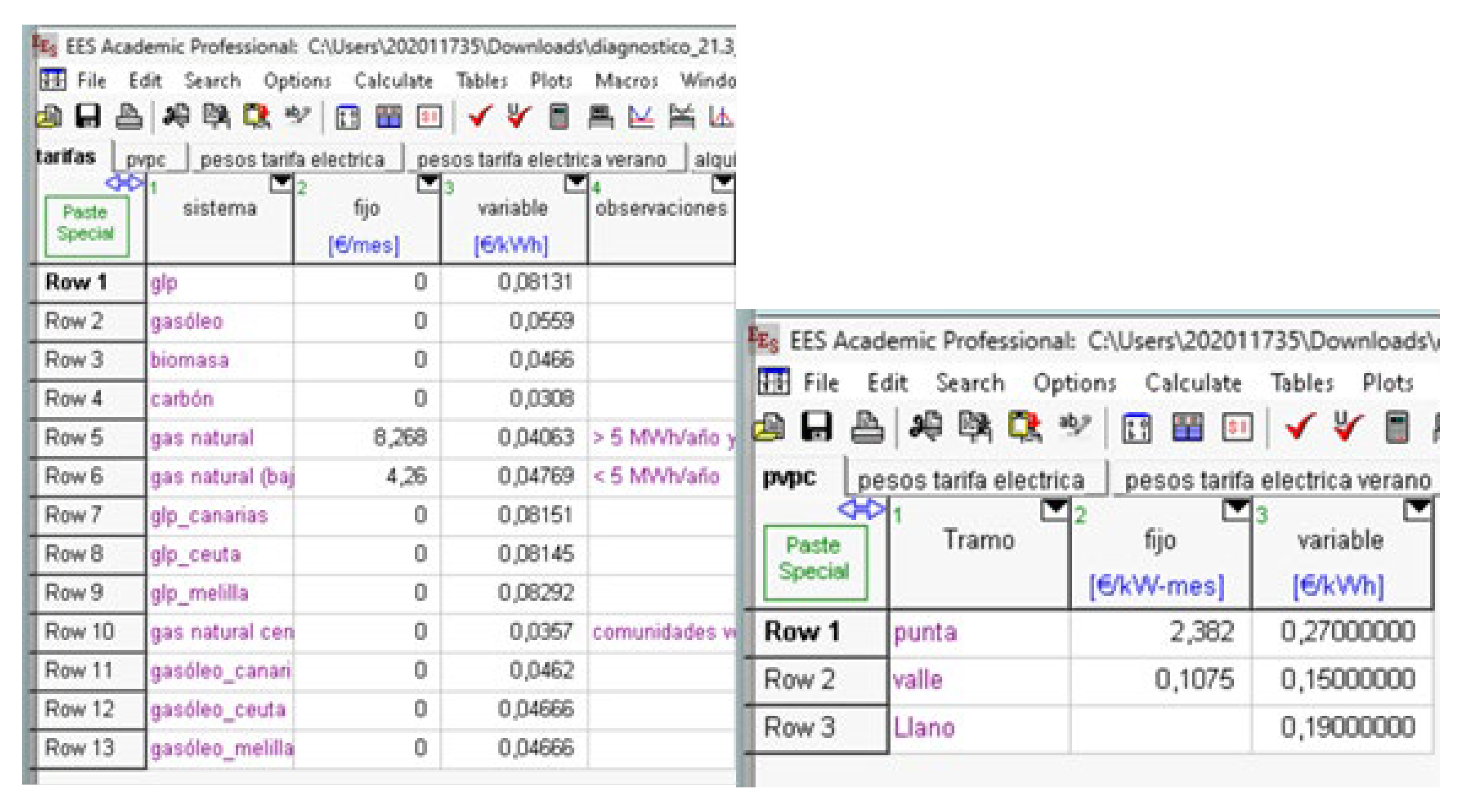
| Province | Heating (Over GTT) | ACS (on GTT) | GTT | Lighting (on GELT) | GEL T | GET |
|---|---|---|---|---|---|---|
| Balearic Islands | 62.00% | 13.79% | 61.45 % | 9.33% | 38.55 % | 100 % |
| Valladolid | 85.56% | 6.76% | 69.52 % | 9.33% | 30.48 % | 100 % |
| Barcelona | 81.83% | 8.55% | 65.12 % | 9.33% | 34.88 % | 100 % |
| Tarragona | 68.07% | 8.64% | 60.68 % | 9.33% | 39.32 % | 100 % |
| Alicante | 58.18% | 11.62% | 61.26 % | 9.33% | 38.74 % | 100 % |
| Valencia | 64.95% | 12.24% | 61.60 % | 9.33% | 38.40 % | 100 % |
| A Coruña | 89.60% | 10.40% | 62.39 % | 9.33% | 37.61 % | 100 % |
| Madrid | 76.75% | 7.76% | 67.13 % | 9.33% | 32.87 % | 100 % |
| Murcia | 62.62% | 17.36% | 56.21 % | 9.33% | 43.79 % | 100 % |
| Ceuta | 74.08% | 9.38% | 66.60 % | 9.33% | 33.40% | 100 % |
| Avila | 92.57% | 6.84% | 67.08 % | 9.33% | 32.92 % | 100 % |
| Province | LED Savings | Saving Thermocover (Single Glazing) | Saving Thermocover (Double Glazing) | Saving Power Strips | Saving on Weather Stripping | Savings on Washing Machine Replacement | Saving Refrigerator Replacement | Saving Glass and Carpentry |
|---|---|---|---|---|---|---|---|---|
| Balearic Islands | 1.74 % | 1.28% | 0.59% | 2.70 % | 3.05% | 2.31% | 5.78% | 4.95% |
| Valladolid | 1.26 % | 2.27% | 1.05% | 1.95 % | 2.97% | 1.67% | 4.18% | 6.54% |
| Barcelona | 1.38 % | 1.99% | 0.92% | 2.13 % | 4.26% | 1.83% | 4.57% | 6.93% |
| Tarragona | 1.58 % | 1.79% | 0.83% | 2.44 % | 3.30% | 2.09% | 5.23% | 5.37% |
| Alicante | 1.78 % | 1.38% | 0.64% | 2.75 % | 2.85% | 2.36% | 5.90% | 4.63% |
| Valencia | 1.75 % | 1.19% | 0.55% | 2.71 % | 3.20% | 2.32% | 5.81% | 5.20% |
| ACoruña | 1.74 % | 1.34% | 0.62% | 2.69 % | 3.91% | 2.30% | 5.76% | 7.27% |
| Madrid | 1.70 % | 1.87% | 0.87% | 2.63 % | 2.58% | 2.26% | 5.64% | 5.67% |
| Murcia | 1.49 % | 1.73% | 0.80% | 2.30 % | 2.82% | 1.97% | 4.93% | 4.58% |
| Ceuta | 1.98 % | 1.18% | 0.55% | 3.07 % | 4.93% | 2.63% | 6.57% | 6.41% |
| Avila | 1.51 % | 1.65% | 0.76% | 2.34 % | 3.10% | 2.00% | 5.01% | 6.83% |
| Province | Savings in Heating Demand |
|---|---|
| Barcelona | 8% |
| A Coruña | 7% |
| Madrid | 5% |
| Seville | 10% |
| Province | Savings in Heating Demand |
|---|---|
| Barcelona | 8% |
| A Coruña | 7% |
| Madrid | 5% |
| Seville | 10% |
| Province | GET |
|---|---|
| Balearic Islands | EUR 2764.11 |
| Valladolid | EUR 3495.94 |
| Barcelona | EUR 3055.17 |
| Tarragona | EUR 2710.16 |
| Alicante | EUR 2750.71 |
| Valencia | EUR 2775.15 |
| A Coruña | EUR 2833.15 |
| Madrid | EUR 3241.70 |
| Murcia | EUR 2433.42 |
| Ceuta | EUR 3190.32 |
| Avila | EUR 3237.07 |
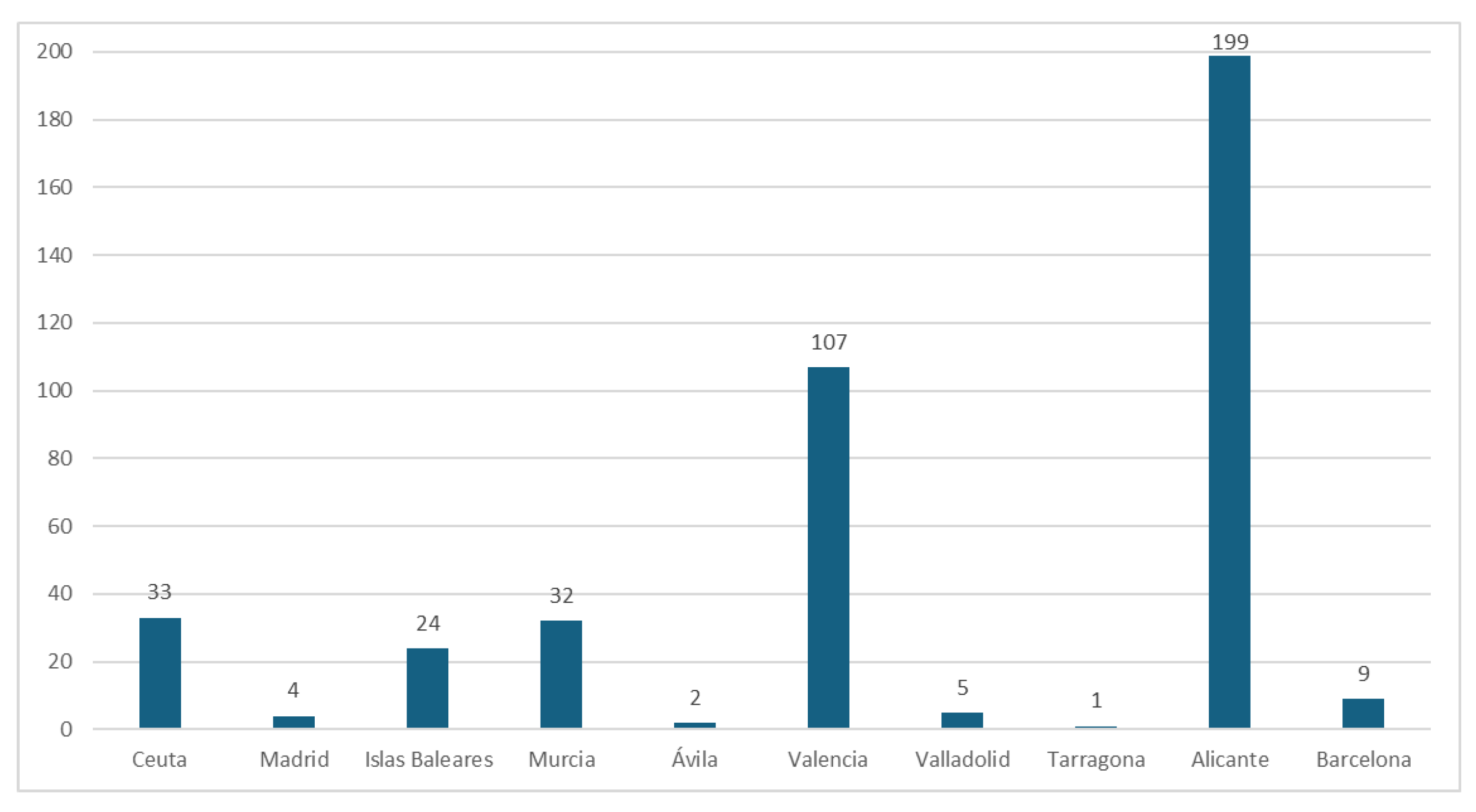
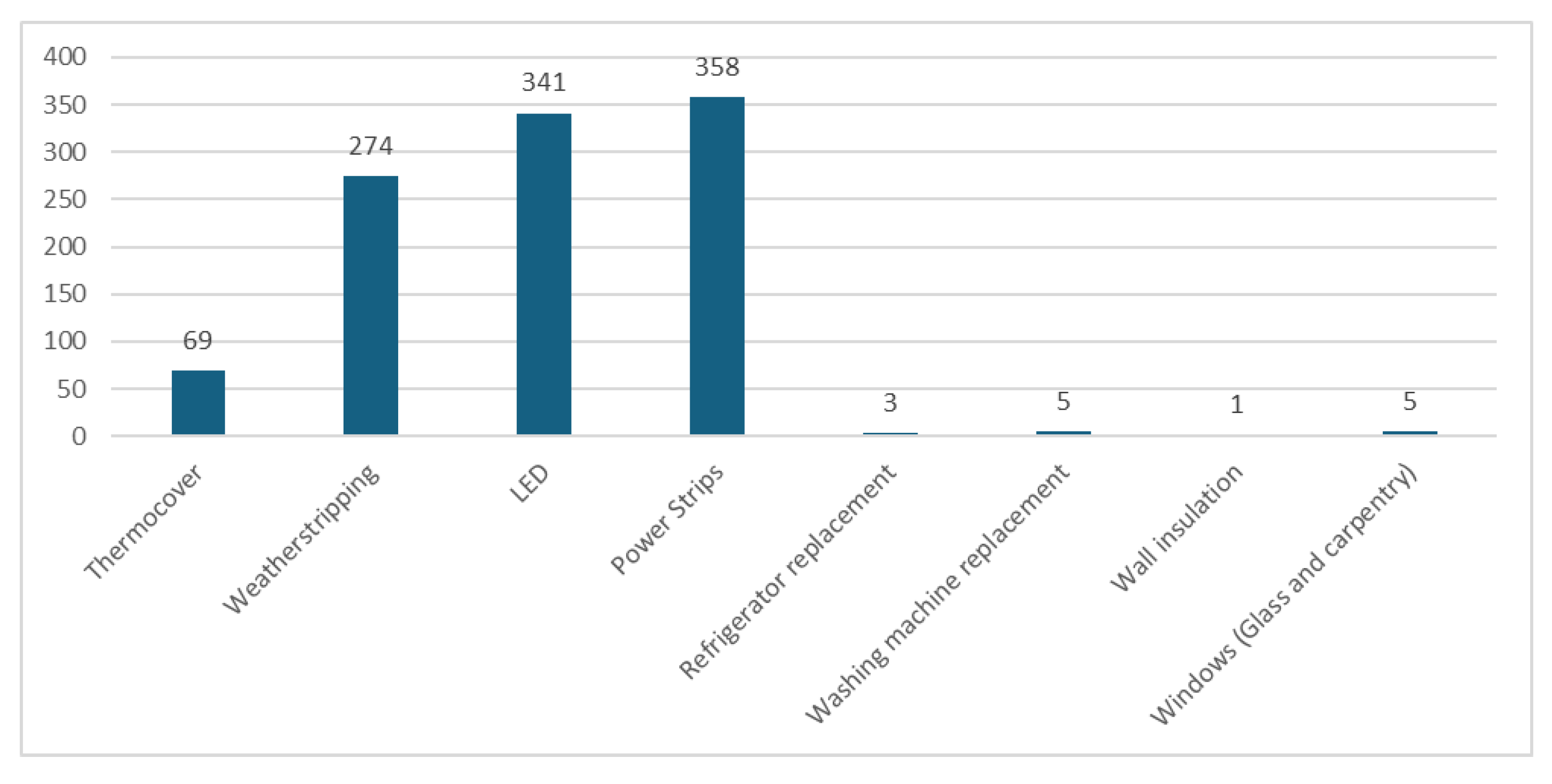
References
- MITECO. Estrategia Nacional Contra La Pobreza Energética 2019–2024; MITECO: Madrid, Spain, 2021. [Google Scholar]
- Carfora, A.; Scandurra, G.; Thomas, A. Forecasting the COVID-19 Effects on Energy Poverty Across EU Member States. Energy Policy 2021, 161, 135907. [Google Scholar] [CrossRef] [PubMed]
- Menyhert, B. The Effect of Rising Energy and Consumer Prices on Household Finances, Poverty and Social Exclusion in the EU; European Commission, Joint Research Centre (JRC): Luxembourg, 2023. [Google Scholar]
- Barrella, R.; Mora Rosado, S.; Romero, J.C. The 2022 Energy and Inflationary Crises: Data, Experiences and Opinions of Spanish Energy Vulnerable Households. Energy Res. Soc. Sci. 2025, 121, 103961. [Google Scholar] [CrossRef]
- Desvallées, L. Low-Carbon Retrofits in Social Housing: Energy Efficiency, Multidimensional Energy Poverty, and Domestic Comfort Strategies in Southern Europe. Energy Res. Soc. Sci. 2022, 85, 102413. [Google Scholar] [CrossRef]
- Dokupilová, D.; Stojilovska, A.; Palma, P.; Gouveia, J.P.; Paschalidou, E.G.; Barrella, R.; Feenstra, M.; Horta, A.; Sánchez-Guevara, C.; Kádár, J.; et al. Exploring Energy Poverty in Urban and Rural Contexts in the Era of Climate Change: A Comparative Analysis of European Countries and Israel. Energies 2024, 17, 2939. [Google Scholar] [CrossRef]
- Barrella, R.; Palma, P.; Gouveia, J.P.; Romero, J.C.; Arenas, E.; Linares, J.I. Toward an Integrated Policy Framework to Address Energy Poverty in the Iberian Peninsula: An Exploratory Analysis. Heliyon 2025, 11, e43414. [Google Scholar] [CrossRef]
- Lima, F.; Ferreira, P.; Leal, V. The Role of Energy Affordability in the Relationship between Poor Housing and Health Status. Sustainability 2022, 14, 14435. [Google Scholar] [CrossRef]
- Sánchez-Guevara Sánchez, C.; Mavrogianni, A.; Neila González, F.J. On the Minimal Thermal Habitability Conditions in Low Income Dwellings in Spain for a New Definition of Fuel Poverty. Build. Environ. 2017, 114, 344–356. [Google Scholar] [CrossRef]
- De Luxán García De Diego, M.; Sánchez-Guevara Sánchez, C.; Román López, E.; del Mar Barbero Barrera, M.; Gómez Muñoz, G. Re-Habilitación Exprés Para Hogares Vulnerables. Soluciones de Bajo Coste; Fundación Naturgy: Madrid, Spain, 2017. [Google Scholar]
- De Luxán García De Diego, M.; Sánchez-Guevara Sánchez, C.; Román López, E.; del Mar Barbero Barrera, M.; Gómez Muñoz, G. Re-Habilitación Exprés Para Hogares Vulnerables. Soluciones de Bajo Coste (Actualización Mayo 2022); Fundación Naturgy: Madrid, Spain, 2022. [Google Scholar]
- Luján Torres, C.; Moliner Galbis, J.; Rodríguez Hernández, J.C.; Vilariño Feltrer, G. Impacto de Las Rehabilitacioes Expres Sobre La Pobreza Energética En Valencia; Universitat Politècnica de València: Valencia, Spain, 2022. [Google Scholar]
- Martín-Consuegra, F.; de Frutos, F.; Oteiza, I.; Alonso, C.; Frutos, B. Minimal Monitoring of Improvements in Energy Performance after Envelope Renovation in Subsidized Single Family Housing in Madrid. Sustainability 2021, 13, 235. [Google Scholar] [CrossRef]
- Bienvenido-Huertas, D.; Berti, K.; Delgado-Gutierrez, E.; Sánchez-García, D.; Marín-García, D. Analysing the Effectiveness of the Energy Conservation Measures to Reduce Energy Poverty Cases in the Southern Regions of Spain. In Energy Poverty Alleviation; Springer: Cham, Switzerland, 2022; pp. 225–238. [Google Scholar]
- Instituto para la Diversificación y Ahorro de la Energía (IDAE) Proyecto SECH-SPAHOUSEC. Análisis Del Consumo Energético Del Sector Residencial En España. Informe Final; IDAE: Madrid, Spain, 2011. [Google Scholar]
- ECODES; Cruz Roja Española. Análisis Del Impacto Proyectos De Lucha Contra La Pobreza Energética; ECODES: Zaragoza, Spain, 2023. [Google Scholar]
- Bernabéu Villena, J. Análisis Prospectivo de La Demanda Energética Residencial e Implementación de Medidas de Adaptación Al Riesgo de Shock de Precios. Master’s Thesis, Universidad Pontificia Comillas, Madrid, Spain, 2023. [Google Scholar]
- Cruz Roja Española; Fundación Naturgy. Informe Final de Actividad; Cruz Roja Española: Madrid, Spain, 2023. [Google Scholar]
- Bradshaw, J.; Middleton, S.; Davies, A.; Oldfield, N.; Smith, N.; Linda, C.; Williams, J. A Minimum Income Standard for the UK; Joseph Rowntree Foundation: York, UK, 2008; Volume 64. [Google Scholar]
- Romero, J.C.; Linares, P.; López, X. The Policy Implications of Energy Poverty Indicators. Energy Policy 2018, 115, 98–108. [Google Scholar] [CrossRef]

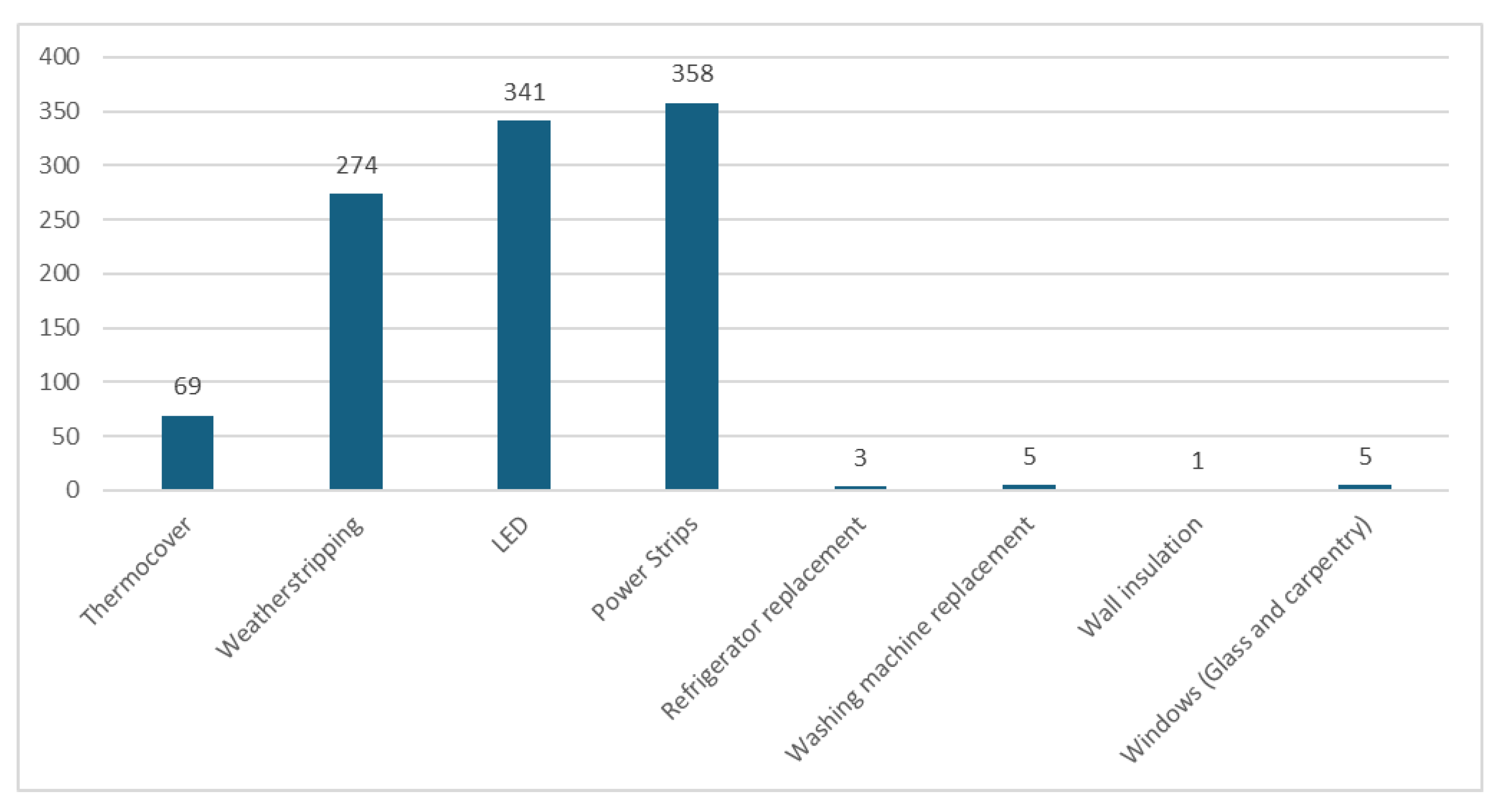
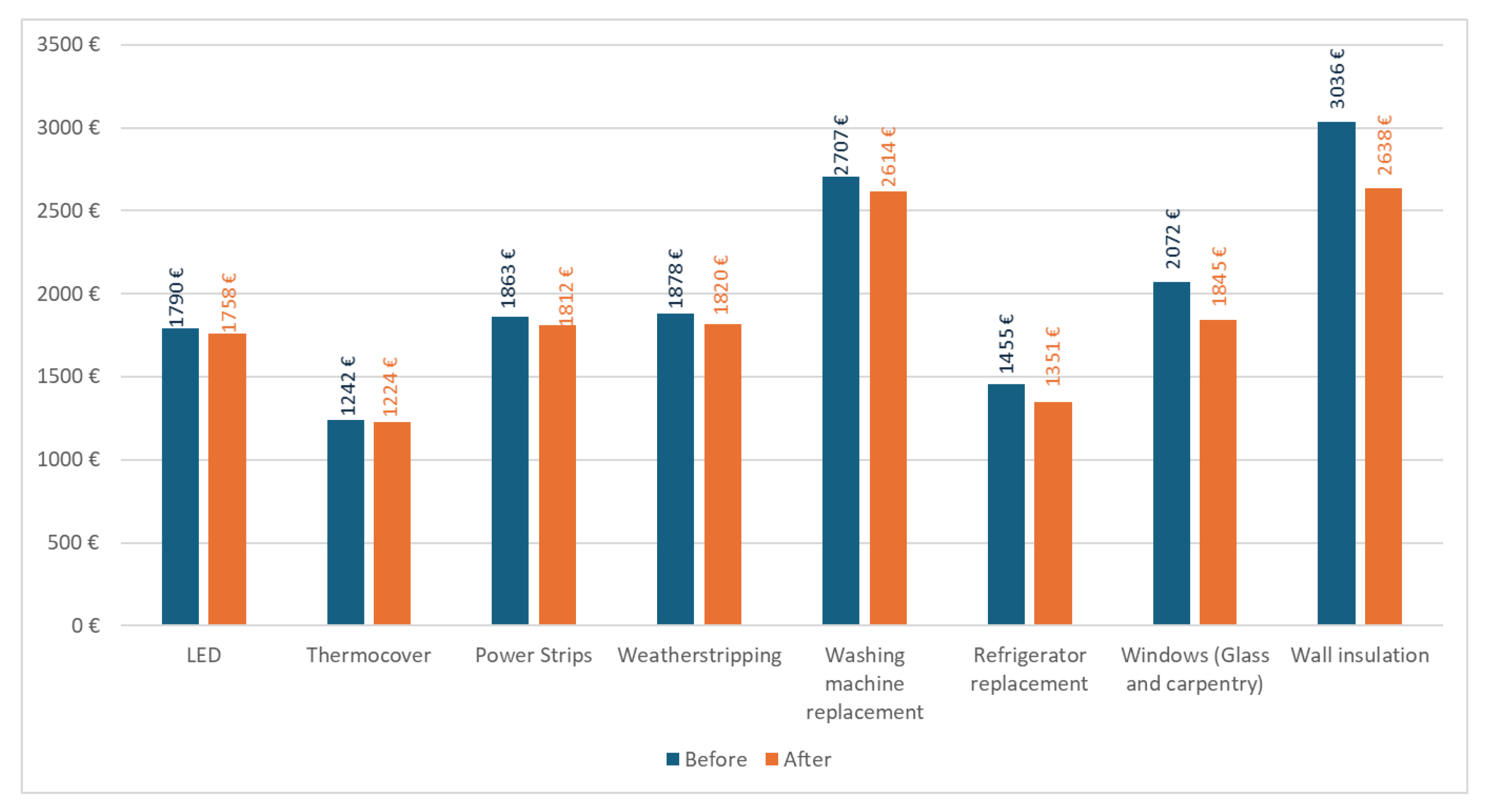
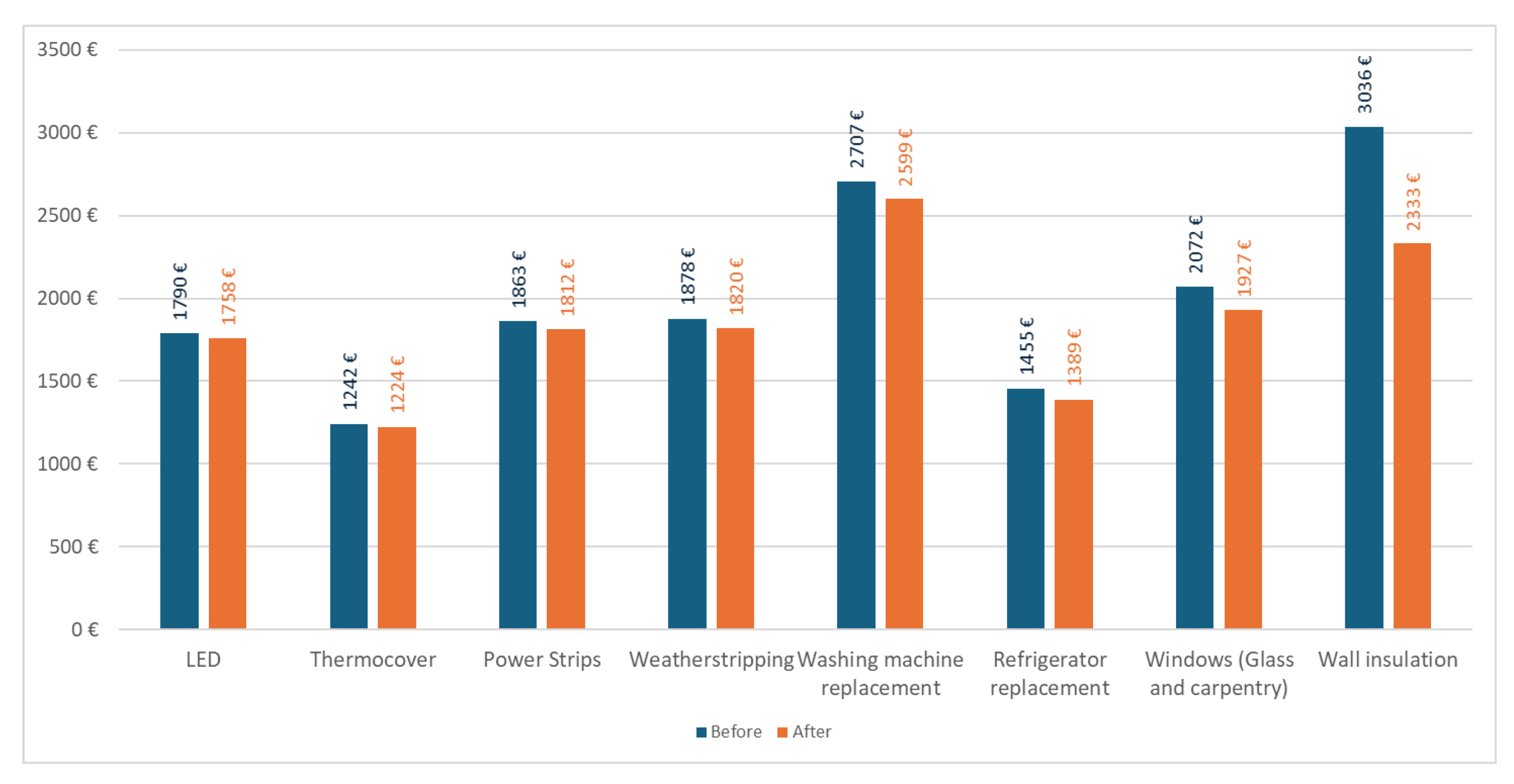
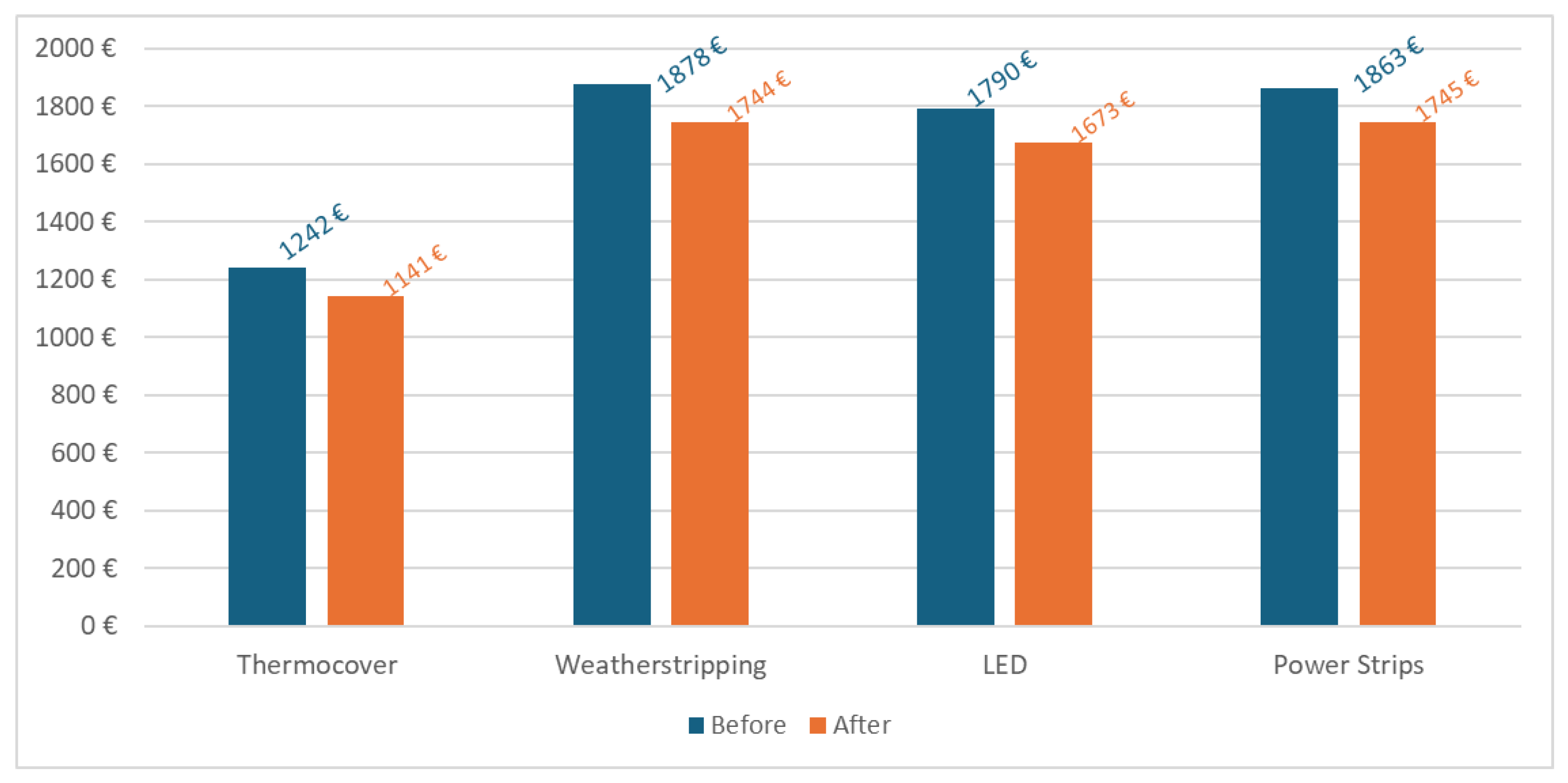
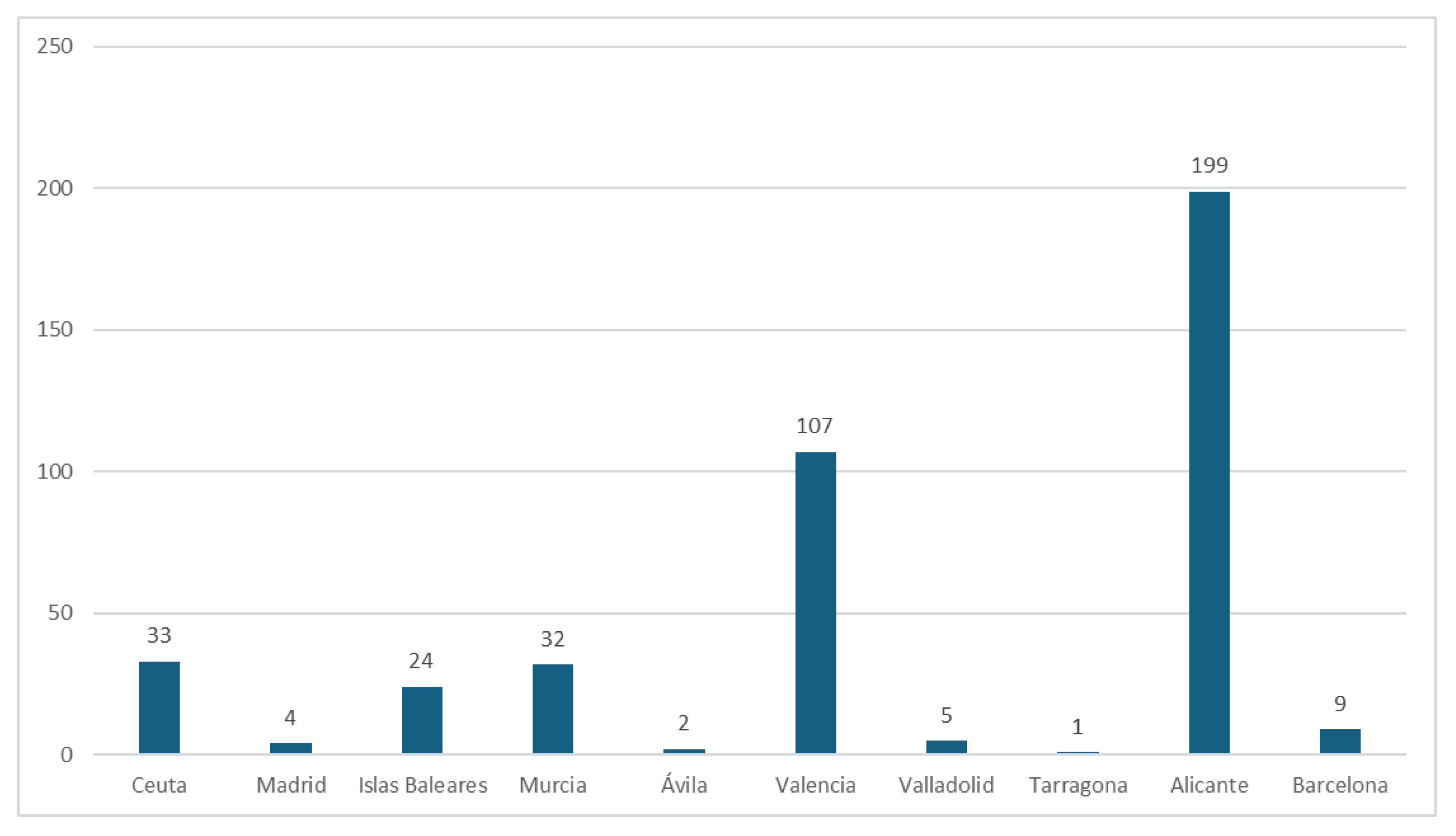
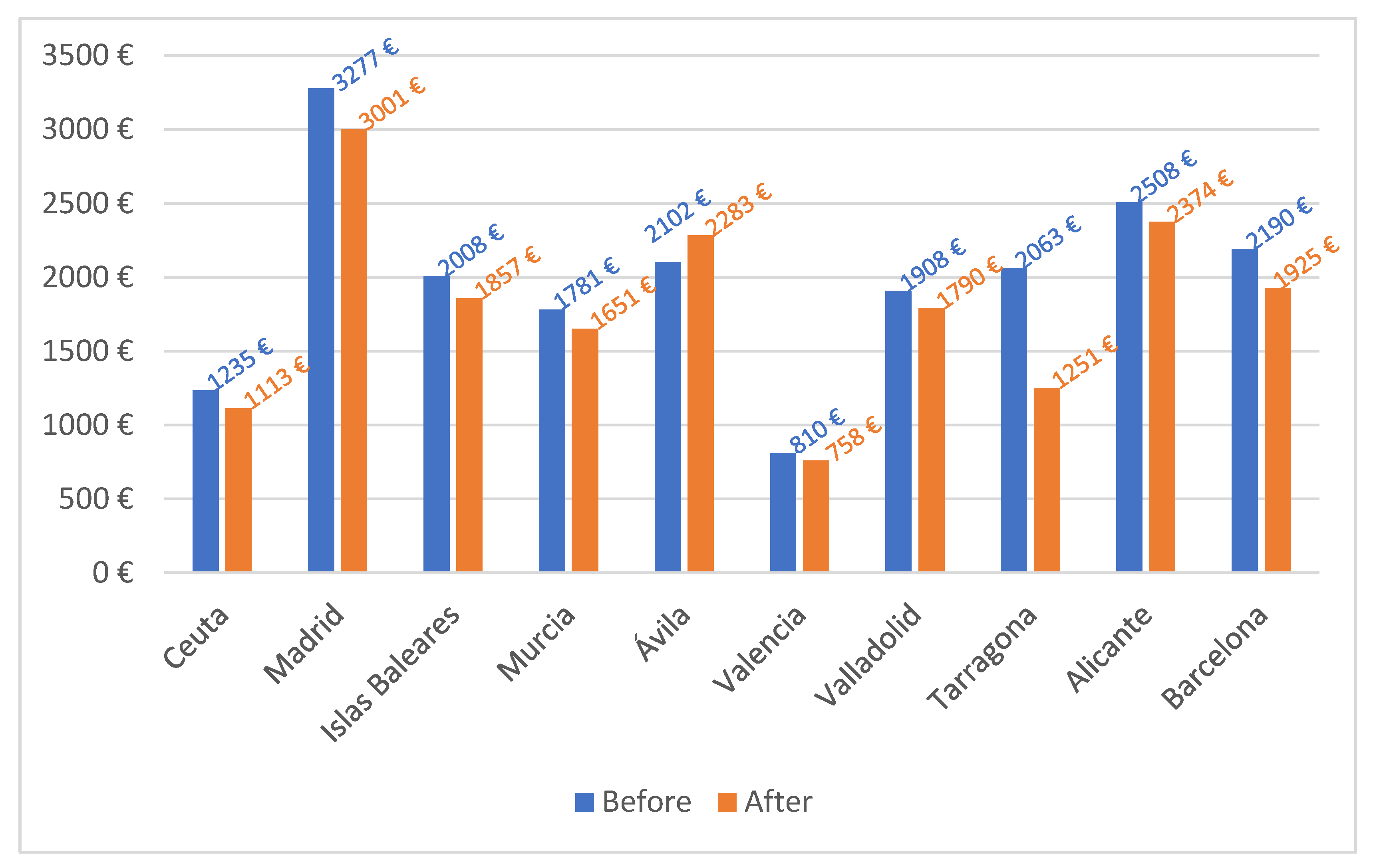
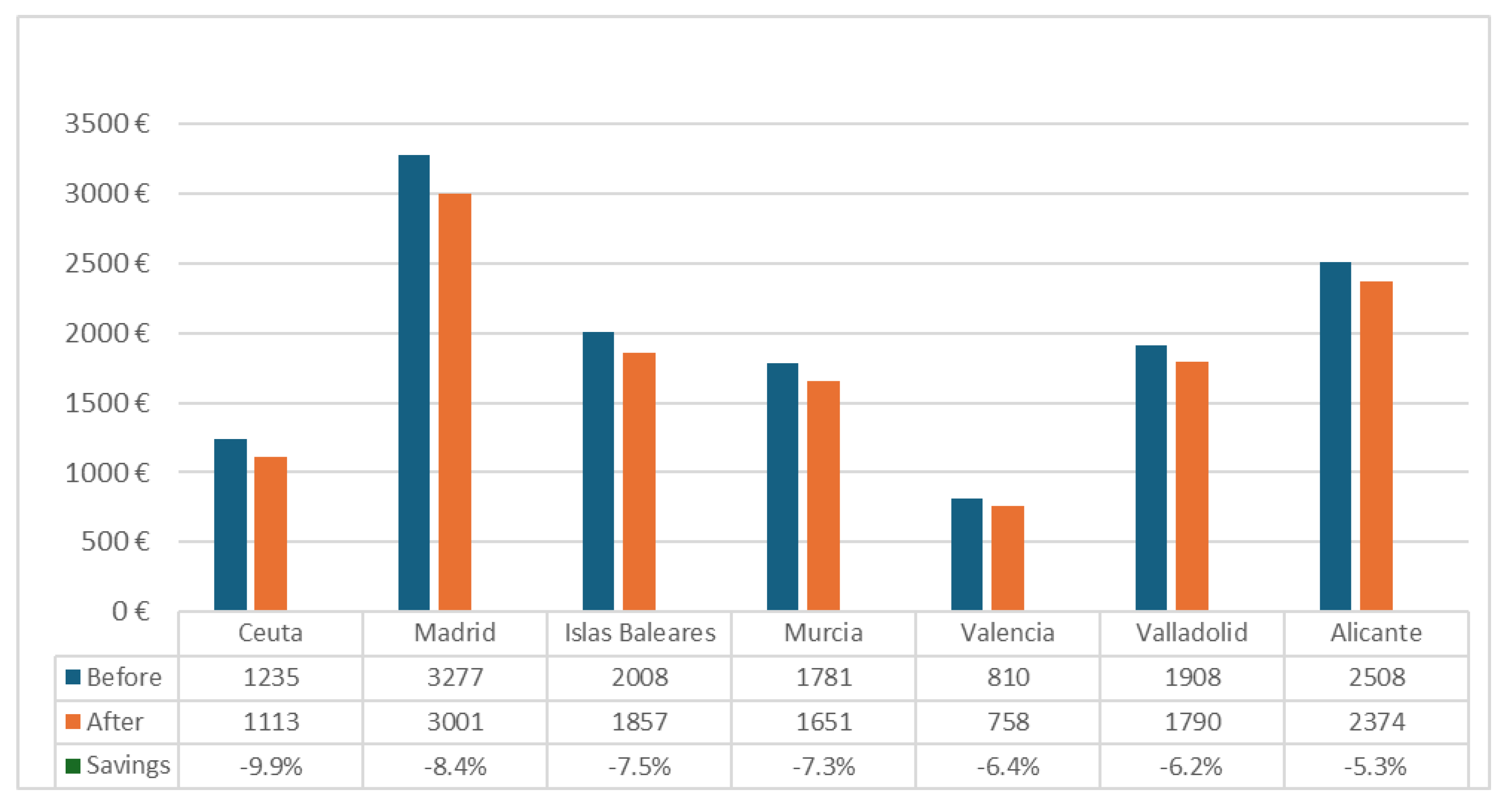
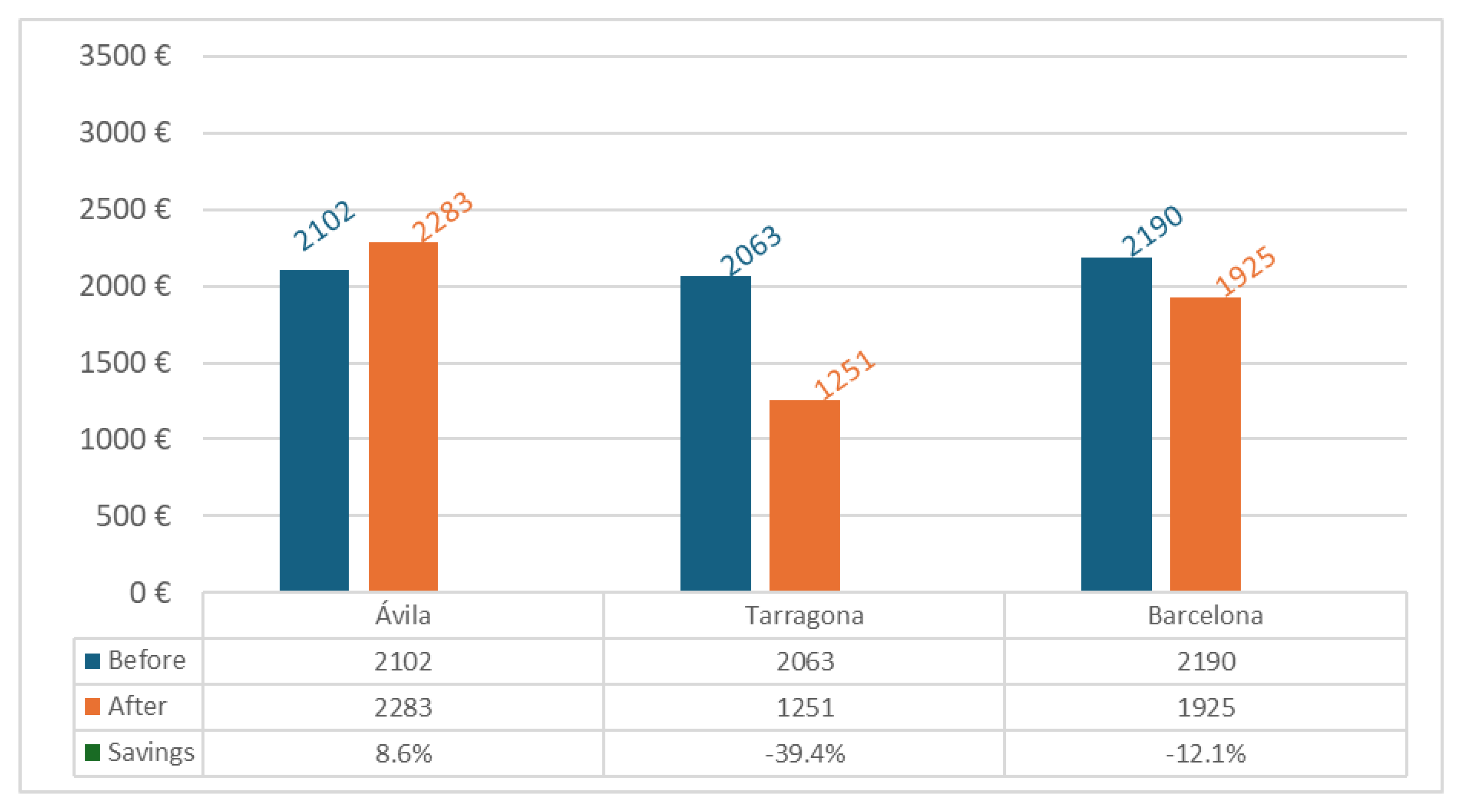
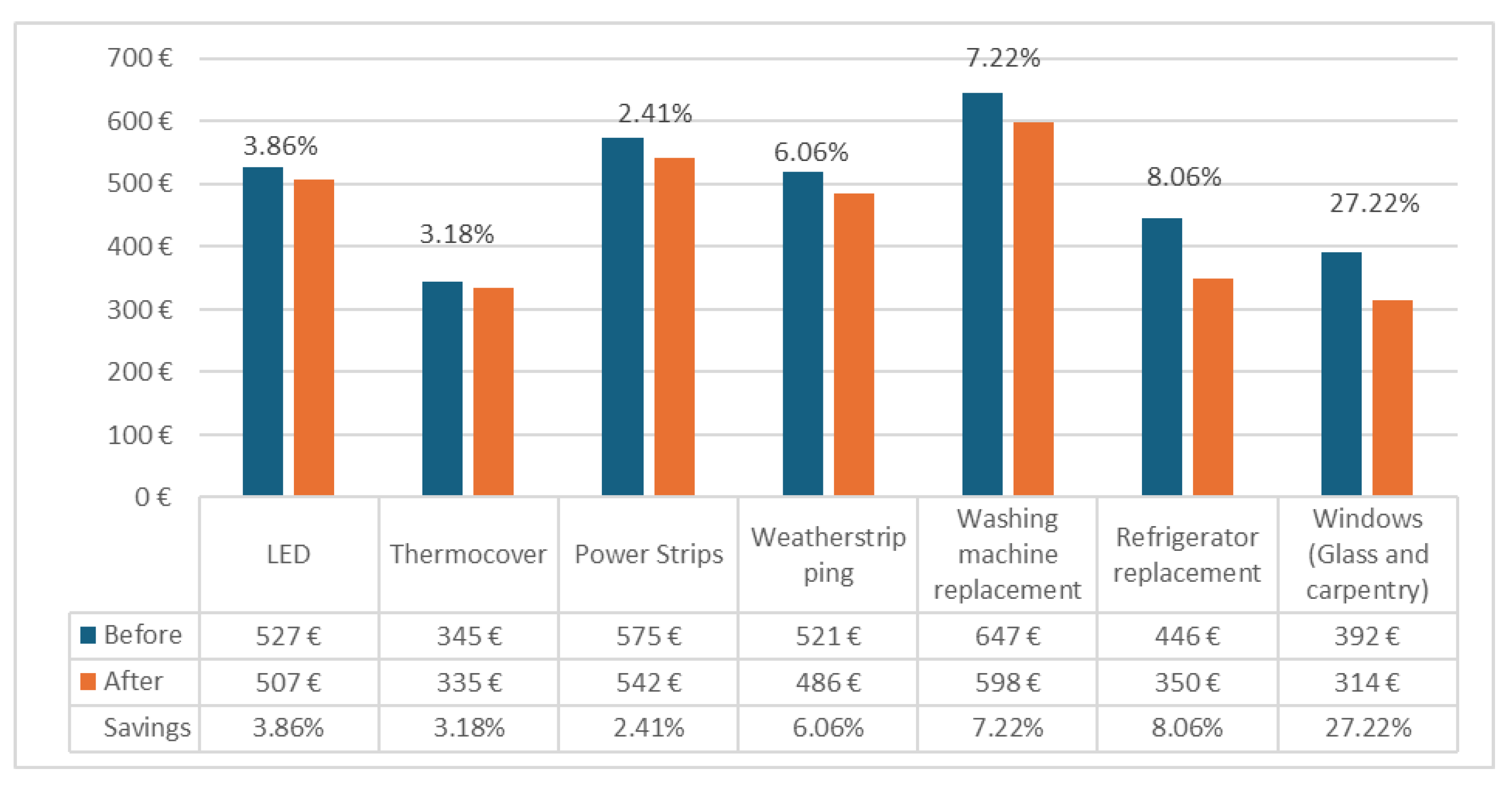
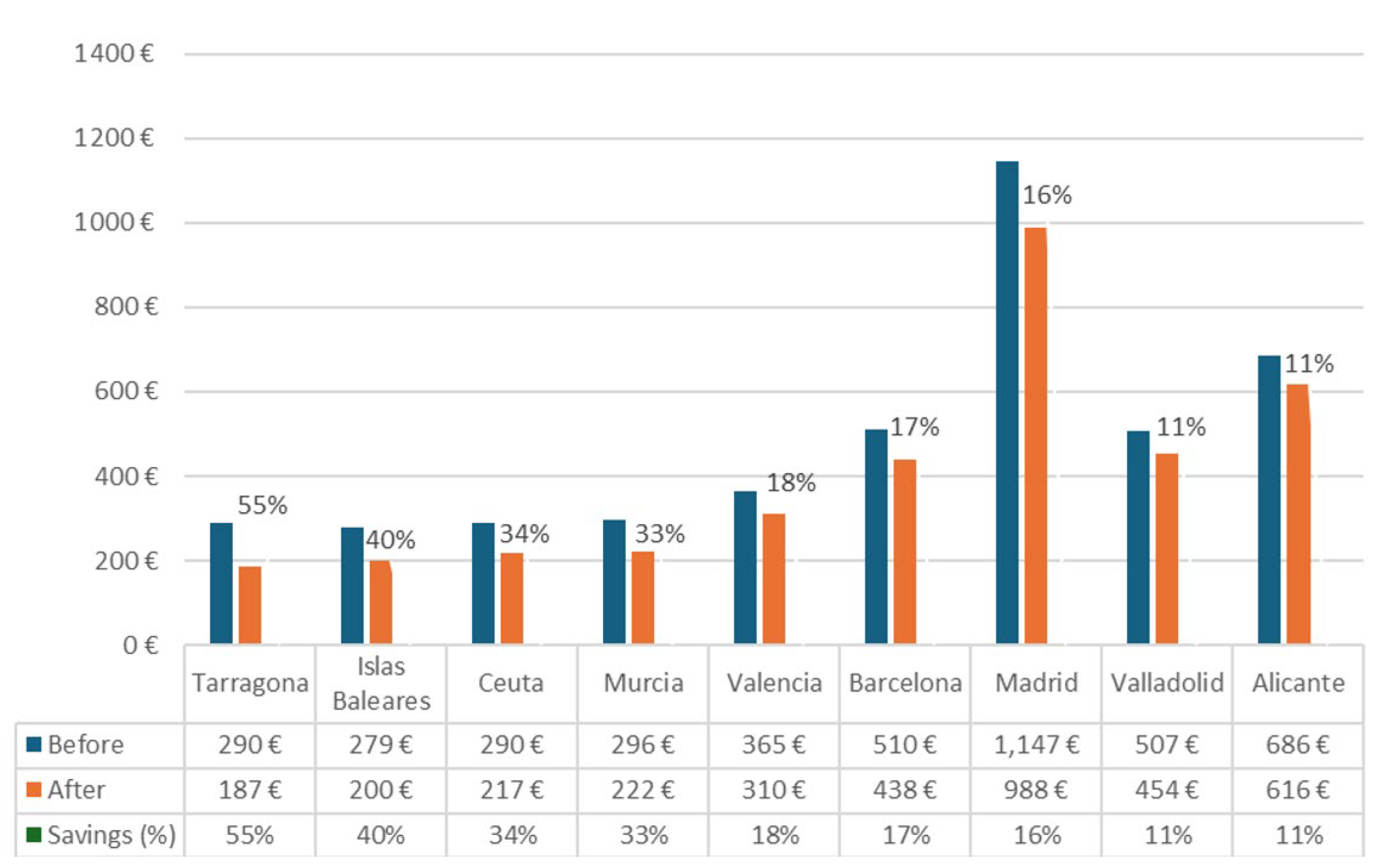
| NGO | No. of Households with Electricity Bills | No. of Households with Natural Gas Bills |
|---|---|---|
| Fundabem (Ávila) | 2 | 0 |
| Roure Foundation (Barcelona and Tarragona) | 5 | 1 |
| Domus Misericordie Sant Josep Foundation (Barcelona) | 3 | 1 |
| Fundació Foment de l’habitatge Social (Barcelona) | 1 | 1 |
| MANCOMUNITAT LA PLANA (Taradell) | 1 | 1 |
| Measure | Savings—Real Case | Savings—Counterfactual Case |
|---|---|---|
| LED | 1.75% | 1.75% |
| Thermocover | 1.33% | 1.33% |
| Power strips | 2.71% | 2.71% |
| Weather stripping | 3.20% | 3.20% |
| Washing machine replacement | 1.83% | 4.15% |
| Refrigerator replacement | 4.57% | 4.79% |
| Windows (glass and carpentry) | 6.58% | 7.51% |
| Wall insulation | 21.32% | 30.11% |
| Measurement Group | Isolated Measure | Joint Measures |
|---|---|---|
| LED | 1.75% | 6.70% |
| Thermocover | 1.33% | 8.14% |
| Power strips | 2.71% | 6.59% |
| Weather stripping | 3.20% | 7.41% |
Disclaimer/Publisher’s Note: The statements, opinions and data contained in all publications are solely those of the individual author(s) and contributor(s) and not of MDPI and/or the editor(s). MDPI and/or the editor(s) disclaim responsibility for any injury to people or property resulting from any ideas, methods, instructions or products referred to in the content. |
© 2025 by the authors. Licensee MDPI, Basel, Switzerland. This article is an open access article distributed under the terms and conditions of the Creative Commons Attribution (CC BY) license (https://creativecommons.org/licenses/by/4.0/).
Share and Cite
Barrella, R.; Romero, J.C. Bridging the Energy Poverty Gap: Evaluating the Impact of Shallow Renovations and Micro-Efficiency in Spain. Sustainability 2025, 17, 5585. https://doi.org/10.3390/su17125585
Barrella R, Romero JC. Bridging the Energy Poverty Gap: Evaluating the Impact of Shallow Renovations and Micro-Efficiency in Spain. Sustainability. 2025; 17(12):5585. https://doi.org/10.3390/su17125585
Chicago/Turabian StyleBarrella, Roberto, and José Carlos Romero. 2025. "Bridging the Energy Poverty Gap: Evaluating the Impact of Shallow Renovations and Micro-Efficiency in Spain" Sustainability 17, no. 12: 5585. https://doi.org/10.3390/su17125585
APA StyleBarrella, R., & Romero, J. C. (2025). Bridging the Energy Poverty Gap: Evaluating the Impact of Shallow Renovations and Micro-Efficiency in Spain. Sustainability, 17(12), 5585. https://doi.org/10.3390/su17125585








